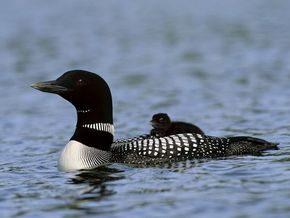Common Loon (Gavia immer)

Description: Loons are often between 28 and 36 inches in size. An adult, breeding loon of either sex is black and white. The head, neck, and dagger-like beak are black, with two sets of short, vertical white stripes ringing the throat. The breast and underbelly are white, and the loon's back is black with white squares covering it. The eyes are ruby red. Loon chicks are completely black.
Habitat: During the summer, common loons are found in Canada, New England, and around the Great Lakes. In the winter, they can be found along the East Coast from Texas to Canada, as well as in the American Southeast. Common loons can be found in lakes, bays, and on the shoreline.
Diet: Loons are carnivores and eat mainly fish and invertebrates found in ponds, lakes, and the ocean.
Behaviors:
Miscellaneous:
Habitat: During the summer, common loons are found in Canada, New England, and around the Great Lakes. In the winter, they can be found along the East Coast from Texas to Canada, as well as in the American Southeast. Common loons can be found in lakes, bays, and on the shoreline.
Diet: Loons are carnivores and eat mainly fish and invertebrates found in ponds, lakes, and the ocean.
Behaviors:
- Loons can dive to depths greater than two hundred feet as they search for food.
- Loon chicks can fly at eleven weeks old. Before that, they ride on their mothers’ backs.
- Loons only leave the water during mating season, when they must incubate their eggs in ground nests.
- Loon nests are little more than a pile of wet plant material.
- Loon clutches consist of two to four brown speckled eggs, which incubate for twenty-seven to thirty days.
- Loon calls are varied, and can sound like crazed laughter, strange yodeling, or more commonly, tremulous wailing.
- Currently, it is believed that loons mate for life.
- Loon courtship rituals are made up of shallow dives and head dipping. They can be seen chasing one another across the water, but this is more concerned with territory than courtship.
- Loons spend summers in New England, Canada, and the states near the Great Lakes. They migrate in flocks to the Gulf of Mexico and the Atlantic Coast during the fall, but very little else is currently known about their migration patterns.
Miscellaneous:
- Loons are featured in many Native American legends, particularly among the Inuit. In one, a loon teaches the Cree Indians to hunt and fish more sensibly. Another legend tells of a loon who brings daylight to the Indians.

